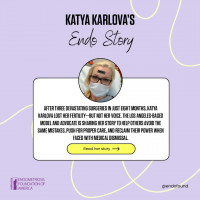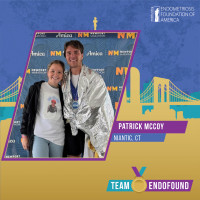Transcript:
There's so much information out there about endometriosis, and I think that can be truly empowering for patients, but I also think that there's a lot of misconceptions out there. So I wanted to just quickly address some of the most common misconceptions about endometriosis. And I know that the lectures in the next couple of days are going to delve a lot deeper into that. I'm also going to disclose that I will be asking for a little audience participation. It's a little early, I know, but I hope everyone had coffee. And I do know some of you, so I'm going to try not to pick on anyone. Okay? But remember, this is a safe space and everybody is here to learn and we are all constantly learning together. Alright, so I'm going to read off a statement and I just want somebody to raise their hand and let me know if they think that that statement is true or false. I use the term fact or fiction and then we're just going to talk about it. Okay? So number one, my periods don't hurt. I can't have endometriosis. So who wants to take this one? Anyone? Okay, back there in the red.
(01:18)
Excellent. Okay, we're starting off. Well, so fiction. So the most common symptom of endometriosis, as we do know, as painful periods. So that's otherwise known as dysmenorrhea. Other common pain symptoms and involve painful bowel movements, also known as dys, geia, painful urination, dysurea, painful intercourse, dys, hernia, some other common manifestations that aren't necessarily pain related. It can be heavy menstrual bleeding, fatigue, brain fog, headache, nausea, GI upset, constipation, diarrhea, urinary frequency, urgency. And this is not, keep in mind a comprehensive list. Alright? 20 to 30% of endometriosis is what we consider silent. So we don't experience the symptoms that we just mentioned. Keep in mind, degree of pain and endometriosis stage do not correlate, which also make this disease very confusing. And endometriosis is a progressive condition. So even if you don't have symptoms this moment, you could develop symptoms in the future. Okay,
(02:28)
So why do we care about silent endometriosis? That might be a good question. A couple of reasons. Up to 45% of unexplained infertility may be due to silent endometriosis. And unexplained infertility means that infertility that has undergone a routine evaluation and they really can't find a reason. And to give you some just very general statistics, normal fecundity. So that's the chance that an average couple is going to conceive each month if they're intimate at about the right time, each month is about 20%. So in the first six months of trying, about 80% of couples will conceive spontaneously, and in about the first 12 months of trying, about 85 to 90% of healthy couples will conceive spontaneously. So if after 12 months and a couple is unable to conceive, there may be something, another etiology at play here, some pathology at play. Something very common is if after 12 months you and your partner are not pregnant, a lot of patients will then move on to see their OB, GYN, to see a fertility specialist. There are a lot of calculators out there, I just picked one. So this is the C-D-C-I-V-F fertility calculator. So we take a 30-year-old normal height, average weight, no prior pregnancies and unexplained infertility. And so after about three cycles of IVF, again, you can see here that about 90% of couples will take home alive birth. So unfortunately, one of the worst cases that I've heard recently is nine years of infertility. So at some point we're hoping this triggers some sort of alert to say, okay, maybe there's another cause at play, maybe endometriosis, osis, something.
(04:28)
Okay, I just want to make a quick comment here about normalization of pain. And I find this to be very common. Endometriosis is so interesting, right? A lot of the symptoms revolve around pain and unfortunately pain is an individual experience. More importantly, pain is progressive. So you don't wake up one day feeling zero pain and then the next day feeling 10 out of 10 pain consistently. So I find that a lot of patients sort of without meaning to are sort of changing their lives. They're starting to miss days of school or work, they're cutting out gluten, they're not eating any dairy, they're basically doing everything they can. And it takes a lot for them to realize that, hey, maybe the things that I'm doing aren't normal. And so this is just a very quick comment to say, you know what, if that's you, then really you should trust your symptoms and speak to someone that will listen to those. Alright, number two, you are 17. You are too young to have endometriosis. Okay, good. All right, fiction. So endometriosis can begin with the first period. Actually symptomatic cases have been reported even before that. Just to give you a few statistics here, about 50% of adolescents, so that's young women aged 10 to 19 undergoing laparoscopy, which is the surgery currently to diagnose endometriosis. When they're undergoing laparoscopy for the indication of pelvic pain, they're found of endometriosis. Additionally, about 70% of adolescents with pelvic pelvic pain that doesn't respond to traditional birth control are also found to have endometriosis.
(06:22)
Interestingly, adolescent endometriosis is more often a cyclic, meaning that pain doesn't necessarily have to coincide with that traditional period pain, that traditional dysentery. And unfortunately that can make it even more difficult to diagnose in this young population. And up to a third of adolescents undergoing laparoscopy four endometriosis had moderate to severe endometriosis. So we used to think, okay, well if it's a young population, maybe we're only going to see very early stage endometriosis. But in fact, this may represent a relatively severe form of endometriosis at a young age. Risk factors for adolescent endometriosis include early menses, so early menarchy, less than the age of 12, a family history of endometriosis, migraines, asthma, and they think potentially due to a altered immune response and malaria anomalies, which these are conditions that affect the development of the reproductive tracts. So the uterus, cervix, ovaries, tubes. So why is this important? Well, roughly 12% of adolescents missed days of school or work each month due to painful periods, and nearly 44% had been to the emergency room at least once, secondary to pain. So we know that of course, again, the delay to diagnosis can be years and it's much more common in this population, and as you can imagine, it can lead to even more severe consequences for them down the road.
(07:59)
Okay, we sort of touched on this one, but I'm still going to say it. So endometriosis increases your risk of having cancer. True or false, anyone? This one actually, we talked about it doesn't cause cancer, but it is associated with cancer. So good. So I called this one fact, of course, all facts with endometriosis always subject to change, but endometriosis affects up to 190 million women worldwide. Endometriosis is considered a benign condition, but it really demonstrates a lot of oncogenic. So cancer like properties. So this is a hungry disease, it creates blood vessels. The word for that is angiogenesis. It likes to spread, it likes to invade things.
(08:46)
So I'm sorry, this is a bit of a busy slide, but in general, this is a study that looked at a bunch of other studies and gave a general what we generally think endometriosis relationship with cancer is. So we do know that it is strongly increases your risk for having two types of ovary cancer and the two types there are clear cell and endometrioid cancers. What's interesting is that of the studies they looked at, some of them noted that that increase was only associated with chocolate cyst, so endometriomas, but that wasn't sort of validated across all of those studies. So again, we do know endometriosis increases your risk of ovary cancer. They noted a very slight risk with breast cancer and with thyroid cancer. Just a quick note here, for the risk with breast cancer only, I think two of those studies really looked at the types of breast cancer. So for patients that are curious, those were ER positive. So those are estrogen receptor positive and progesterone receptor negative PR negative type cancers, which makes sense in the context of the disease. And as end of note, there was no increased risks of colorectal cancer or endometrial cancer.
(10:09)
So unfortunately we don't really have widely accepted guidelines that exist in regards to endometriosis and cancer screening. So I would say the best thing to do is to create a plan with your endometriosis provider to talk about your own reproductive goals, your personal risk factors, and your family history. Okay, next, a hysterectomy will lead to immediate menopause.
(10:38)
Very good. All right, fiction. So I'd want to briefly just go over the types of hysterectomy, and one of those does lead to menopause, but the three main types of hysterectomy. The first is a supracervical, so above the cervix or a subtotal hysterectomy, and that involves removal of just the uterus. A total hysterectomy is uterus plus the cervix, and a complete hysterectomy is uterus, cervix, and both ovaries, and that does lead to menopause. Okay, I see this term a lot, which is just why I wanted to include it here. There's something called a radical hysterectomy, and that term is actually often used incorrectly. It's used in a lot of advanced stage endometriosis surgery, as well as in oncology cancer surgery. It can involve removal of some of the tissues surrounding the uterus. It can involve tissue such as the vagina, but it actually doesn't have to include removal of the ovaries.
(11:40)
Okay? Each hysterectomy type that we just talked about includes removal of both fallopian tubes and for a good reason. So this actually reduces your future risk of ovary cancer. And there's two main types of procedures that involve tubes. The most common used to be a tubal ligation, so tying your tubes, and that actually also reduces your risk of ovary cancer, about 20 to 40%. Very interestingly, the impact was the greatest on the types of ovary cancer that were associated with endometriosis. So just like what we talked about, that clear cell and that endometrioid carcinoma. The other procedure, which is very common now, which is I would say standard of care for hysterectomies is complete tubal removal, and that's also known as the salpingectomy. And that has been associated with an almost 64% reduction in ovary cancer. So what happens if you take out one ovary? So in general, menopause occurs about one to two years earlier. So the average age of menopause in the US is about 51, so that would mean 49 50, but anything after 40 can be considered normal. And you have to also keep in mind that that's in healthy ovaries. So if there's something else causing early menopause, that would be different.
(13:07)
Okay, number five, there is no way to diagnose endometriosis without surgery. Anyone.
(13:21)
Okay, I will give you that one actually, because I called this fact technically 100% gold standard is via surgery still, but we'll talk a little bit about that. Okay. So technically diagnosing endometriosis now is by surgery typically laparoscopy. So small incision surgery where you insufflate the belly full of gas, you do excisions, you take biopsies, you take those biopsies, you send them over to our friends, the pathologist, they look at them under a microscope and then they confirm that this is the specific type of cells that they're looking for, and that would be endometriosis, this.
(14:04)
But there are some ways to noninvasive ways to diagnose endometriosis and be relatively certain. So I would say that really currently, no truly accurate, 100% accurate imaging exists to test first stage one slash two disease. So that's very early stage disease. Four, advanced stage disease, that's three slash four, otherwise known as deeply infiltrative endometriosis. There are specialized ultrasound protocols, MRIs, that can really get very, very high accuracy, and that's specifically to with those ovarian endometriomas or those ovarian cysts, and they can be very accurate in diagnosing endometriosis. Just keep in mind that when you're looking at imaging, ultrasound is highly operator dependent, and that imaging should really be interpreted by providers that understand that disease. Okay, I just want to make a quick plug, but there are a lot of researchers right now looking at different ways to diagnose endometriosis prior to surgery. So researchers are looking at saliva tests, and we have researchers that we are working with here in the US that are trying to see if we can diagnose endometriosis in menstrual blood. And if that happens, that would be revolutionary. And actually one of them is speaking later today. Alright, just two more. So antibiotics can treat endometriosis.
(15:33)
Okay, great. False. Okay, so currently endometriosis is not caused by an infection. You cannot contract endometriosis in this room. We do know that an impaired immune system and a chronic inflammatory state can contribute to its development. No antibiotics have been proven to treat or cure endometriosis in humans. There are some very promising models that focus on antibiotics and your various microbiomes and the progression of endometriosis. In the interest of time, I really just picked one article, and when you do this big search, so many things will come up, but I like this one because it seemed saying endometriosis may be caused by this bacteria. And so the bacteria that they were talking about as something called fusobacterium, fusobacterium is a bacteria that's very common in the oral and gut tracts. Several species have been found to create inflammation, and they're thinking chronic inflammation can trigger endometriosis like growth and development.
(16:40)
Okay, so quickly about this study, they actually did something very interesting. They basically identified mechanisms by which endometriosis form, so a lot of inflammatory mechanisms. And then they set out to prove that this bacteria could also create these changes. They then took mice, they gave them endometriosis, and then they also gave them this bacteria, and they said that, Hey, mice with this bacteria had notably larger lesions. They then decided to treat those mice and found that those lesions reduced in size and it decreased inflammatory markers. So that was a really interesting finding. Separately, they also took some humans, 76 patients with endometriosis and 76 patients without endometriosis and tested them for the bacteria. So they said, okay, well, 74 patients, 74% of patients with endometriosis tested positive for this bacteria versus 7% who did not. And while that is significant, again, it wasn't 100% of those patients, and these are quotes from this actual study. So these were very exciting studies. This was a very exciting study, but there were some limitations. So as we mentioned, the study lacks direct evidence that the presence of this bacteria in a human endometrium promotes endometriosis. Secondly, studies are really required to figure out whether if you give antibiotics against this bacteria that will actually treat patients with endometriosis. So we just haven't made enough of those steps yet, but I think that that's very exciting.
(18:24)
Okay, last one. Pregnancy cures endometriosis. What did you say? Fiction. Okay, great fiction. So number one, we know there's no cure for endometriosis, but pregnancy is not one of those. Okay? So medical management centers tends to center around reducing estrogen. We're often treating patients with high dose progesterones. Keep in mind, pregnancy is a high progesterone state and it's an amen state so you don't have periods. So patients will often say that they feel better or that their symptoms have gone away, and this can really continue during breastfeeding. So in a way, pregnancy can act as a temporary treatment, but also keep in my pregnancy doesn't come without some risks. And this is just one study by Ms. Mer. She looked at about 200,000 pregnancies and looked at patients with laparoscopically proven endometriosis and noted that they were at a slightly increased risk for adverse pregnancy outcomes, and the most common being spontaneous miscarriage, ectopic pregnancy, those. So that's pregnancy in the wrong location, gestational diabetes, and high blood pressure type disorders. Again, unfortunately, no standardized guidelines exist for pregnant women with endometriosis. I just wanted to say here, most importantly, pregnancy should not be suggested against patient preference. Even if you do, even if there is a good chance that you will feel better.
(20:04)
In summary, your periods do not have to hurt for you to have endometriosis. You are not too young to have endometriosis. Endometriosis can increase your risk for having cancer. Hysterectomy alone does not result in immediate menopause. The gold standard right now to diagnose endometriosis is surgery. Antibiotics are not currently used to treat endometriosis, and pregnancy does not cure endometriosis. Okay, these are a few of my references. Thank you.










